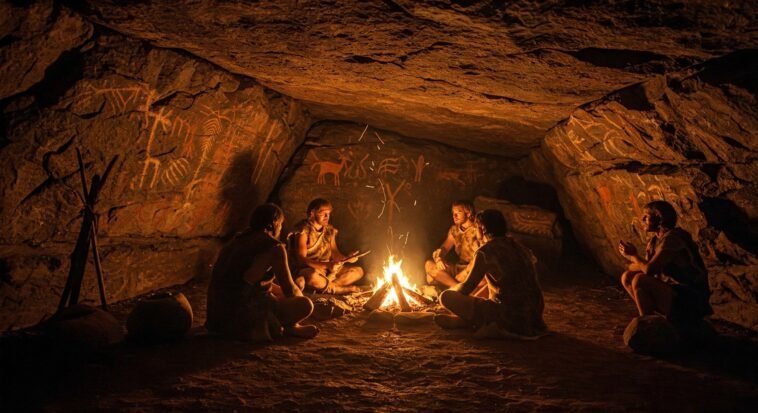
Forget what cartoons told you—early humans weren’t just grunting cave dudes throwing rocks and chasing mammoths.
That’s Hollywood talking, not history.
Thanks to modern science (yep, even DNA tests), we now know Stone Age people were smart, creative, and seriously resourceful.
They had tools, art, style—and probably way better survival skills than most of us with Wi-Fi and snack deliveries.
This article busts five Stone Age myths and replaces them with the real tea.
Spoiler alert: They didn’t all live in caves, and they definitely weren’t clueless.
Myth 1: Stone Age People Were Dumb and Uncivilized
Hold up—just because they didn’t have iPhones or TikTok doesn’t mean they were clueless.
Stone Age humans were total brainiacs for their time.
No Wi-Fi? No problem.
They still built tools, started fires, and probably had better group projects than half your class.
Evidence of intelligence:
- Tool hackers: Over 2 million years ago, Homo habilis was already crafting tools from stone like a prehistoric MacGyver.
- Fire masters: Early humans were roasting food and bonding around campfires a million years ago. That’s right—they had BBQs before it was cool.
- Art + emotion: They painted cave walls, made jewelry, and even held burial rituals. That means they weren’t just surviving—they were thinking deeply, feeling stuff, and expressing it.
Source: Wynn, T., & Coolidge, F. (2010). How to Think Like a Neandertal.
- Read also: Explained: How Prehistoric Human Evolution Is Mapped Incorrectly
- Read also: Prehistoric Myths: What We Got Wrong About Early Humans
Myth 2: Everyone Lived in Caves
Okay, we’ve all seen the caveman cartoons—rock houses, bone furniture, yelling “Ugga Ugga!”
But here’s the truth: caves were more like the Airbnb of the Stone Age, not everyone’s forever home.
Here’s what they actually lived in:
- Bone mansions: In places like Mezhirich, Ukraine, people built houses out of mammoth bones. Yep, imagine living in a giant ice-age igloo made from actual beast bones.
- Pop-up tents, but make it ancient: Hunter-gatherers made cozy hide shelters from animal skins—like camping, but for survival (and probably no marshmallows).
- Starter villages: By the later Stone Age, humans were leveling up with mud-brick houses in full-on villages like Çatalhöyük.
So no, they weren’t all crammed in caves. That’s just where their stuff lasted long enough for scientists to find it.

Myth 3: Stone Age People Had Short, Brutal Lives
We’ve all heard it: “Back then, you were ancient by 25.” Sounds dramatic—but it’s not the full story.
Sure, life was tough (no hospitals, no DoorDash), but if you made it past childhood, you had a solid shot at growing old and grumpy like the rest of us.
What actually happened:
- Low average, not early death sentence: Life expectancy at birth was about 30–35, but that number drops hard because babies and toddlers had it rough.
- Survivors thrived: If you made it to your teen years, you could totally live into your 40s, 50s—even longer. That’s like being a prehistoric grandma with legendary storytelling skills.
- Stone Age squad goals: Fossils show people with serious injuries who healed. Even in the Stone Age, humans were out here building community and showing empathy.
They didn’t just live fast and die young.
They fought hard, helped each other, and many stuck around long enough to see grandkids—and probably complain about “kids these days.”
Myth 4: Men Hunted, Women Gathered—Always
You’ve seen it in every cartoon: dudes with spears chasing mammoths, while women gather berries like they’re shopping at ancient Whole Foods.
But that stereotype? It’s way oversimplified—and pretty outdated.
Here’s the tea:
- Girl boss with a spear: In Peru, archaeologists found a 9,000-year-old grave of a woman buried with hunting tools. She wasn’t just collecting herbs—she was out there hunting big game.
- Teamwork vibes: Modern hunter-gatherer groups, like the Hadza in Tanzania, show that women sometimes hunt too, and guys? Yep—they help gather. Roles weren’t locked to gender like a bad school group project.
- Skills > Stereotypes: Jobs were based on stuff like age, ability, and what needed doing—not just “because you’re a guy” or “because you’re a girl.”
Moral of the story: The Stone Age had more role flexibility than some 90s sitcoms. It wasn’t all macho hunters and berry moms—it was survival, and everyone pitched in.
Myth 5: Agriculture Was an Instant Upgrade from the Stone Age
You might think switching from hunting to farming was like upgrading from a flip phone to an iPhone—but nope.
Early farming was more like trading freedom for chores, back pain, and… way more cavities.
Here’s the real plot twist:
- Grain brain: Early farmers ate a lot of carbs. Sounds dreamy? Not really. Their diets caused tooth decay, anemia, and shorter height. Basically, less protein = less power-up.
- Germs galore: Living in crowded villages with no plumbing? Yeah, not ideal. People got sick more often thanks to dirty water and human (and animal) poop hanging around.
- Rich vs. poor starts here: Farming made it easier to hoard food and land. Cue the first social inequality, power struggles, and even—yikes—slavery.
Bottom line: Farming wasn’t all cozy cottages and full pantries. For many early humans, it meant working harder, eating worse, and dealing with drama. Not quite the dream upgrade history class makes it sound like.

Why These Myths Matter
So why should we care about debunking Stone Age myths? Well, here’s why it actually matters:
- It blows up old-school ideas: Busting these myths shows that early humans weren’t just “dumb cavemen.” They were smart, adaptable, and way ahead of what pop culture gives them credit for.
- It shows how creative and flexible humans really are: Prehistoric people weren’t one-size-fits-all. They got creative with survival—and that’s something we can learn from today.
- It puts modern life in perspective: All the cool stuff we take for granted today, like tech and farming, came with some serious trade-offs. Understanding the cost of “progress” helps us appreciate how far we’ve come—and what we might still need to fix.
Plus, these myths pop up everywhere: movies, books, even in casual convos.
So, by setting the record straight, we get a clearer picture of our past—and maybe even a better idea of where we’re going.
Quick Recap of the 5 Myths—Debunked
| Myth | Reality |
| 1. Stone Age people were dumb |
They were smart problem-solvers with rich cultures
|
| 2. Everyone lived in caves |
Most lived in huts, tents, or early houses
|
| 3. People died at 30 |
Many lived into their 40s, 50s, or more
|
| 4. Men hunted, women gathered |
Gender roles varied across societies
|
| 5. Agriculture improved everything |
Farming brought both gains and problems
|
- Read also: Bronze Age vs. Stone Age: What Changed (And Why It Matters)
- Read also: Stone Age: A Complete Guide to Prehistoric Human Life
Conclusion: Prehistory Wasn’t Primitive
The Stone Age wasn’t some boring chapter of “how to survive without Wi-Fi.” It was actually a time full of invention, adaptation, and big brain moves.
These so-called “cavemen” weren’t just sitting around throwing rocks—they were laying the groundwork for art, language, communities, and even science (seriously).
By ditching the myths and checking out the real facts, we get a much clearer, more exciting picture of our ancient ancestors.
And guess what? The same creativity and teamwork that got humans through the Stone Age?
Yeah, it’s the same stuff that’s helped us make it this far.



